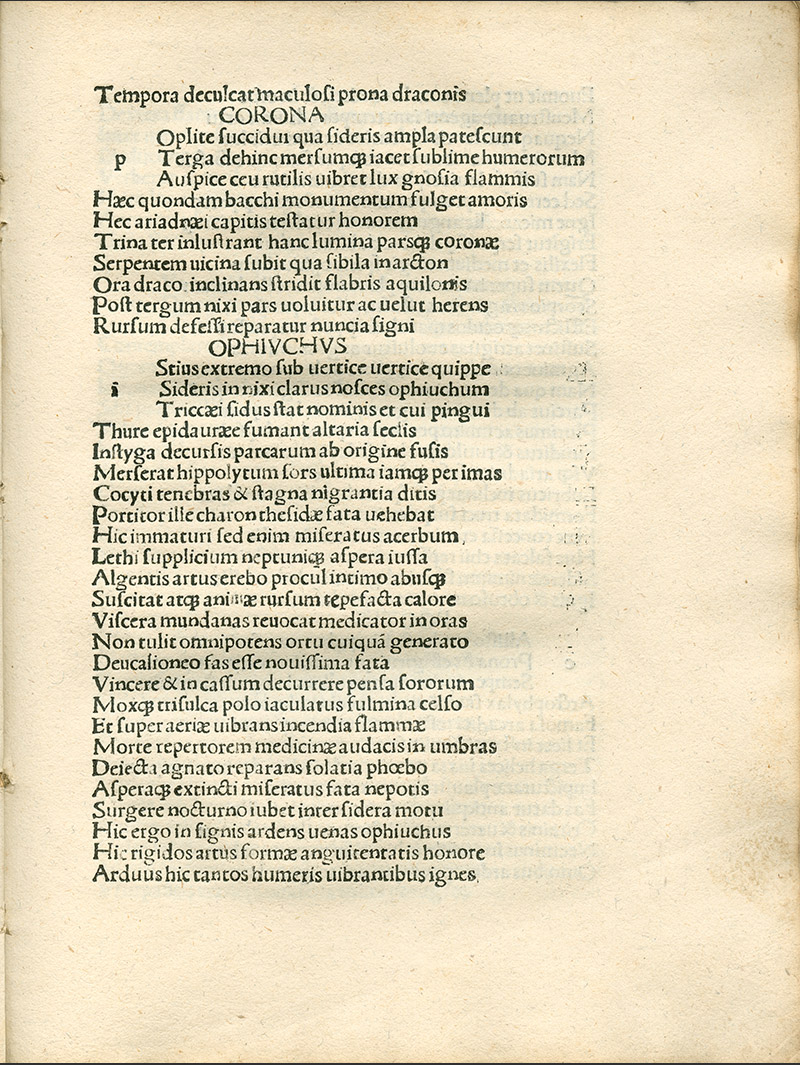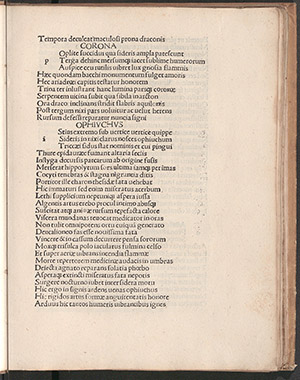Avienus’ Aratea

- Avienus, Aratea, lines 157-168 (Dragon), 169-192 (Engonasin).
- Rufius Festus Avienus, Arati phaenomena. Ed: Victor Pisanus. Add: Dionysius Periegetes: De situ orbis (Tr: Avienus). Avienus: Ora maritima. Aratus: Phaenomena (Tr: Germanicus, with comm). Aratus: Phaenomena (Tr: Cicero). Quintus Serenus Sammonicus: Carmen medicinale.
- Venice: Antonius de Strata, de Cremona, 25 Oct. 1488.

- Avienus, Aratea, lines 193 (Engonasin), 194-203 (Northern Crown), 204-228 (Serpent-Bearer).
- Rufius Festus Avienus, Arati phaenomena. Ed: Victor Pisanus. Add: Dionysius Periegetes: De situ orbis (Tr: Avienus). Avienus: Ora maritima. Aratus: Phaenomena (Tr: Germanicus, with comm). Aratus: Phaenomena (Tr: Cicero). Quintus Serenus Sammonicus: Carmen medicinale.
- Venice: Antonius de Strata, de Cremona, 25 Oct. 1488.
Later on in the fourth century, Avienus (ca. 305-post 360), a prominent politician, who served as proconsul in Africa and Achaia, produced another translation of Aratus’ Phaenomena. His Aratea (probably finished in 360 CE) is the only complete translation of Aratus’ poem we have, since Avienus also translates the meteorological section of the Phaenomena. In fact, Avienus’ translation is much longer than the original (1878 lines compared to the 1154 lines of Aratus), enriched with descriptions and stylistic embellishment. In particular, Avienus adds Stoic nuances to the poem: in his opening Hymn to Zeus (76 lines against the 18 of Aratus) Jupiter is now identified with the entire cosmos, and he is seen as the origin of all movement in the universe and its creator. Avienus mentions Eudoxus (Arat. 53) and then Aratus (Arat. 64), recognizing his own debt to the past tradition. The description of constellations translates the original 432 lines of Aratus into 831 lines of Latin.
While Germanicus had corrected Aratus through Hipparchus, Avienus is more faithful to the original. Still, the latter adds mythological narratives to explain the origin of the constellations, taking them from the Catasterismi and other sources. For example, in the page shown here (see the first image), taken from the 1488 edition of Avienus, Germanicus and Cicero, Avienus describes the Kneeler (Arat. 169-193), as is clear from the title “Engonasin”, which is transliteration of the Greek Ἐνγόνασιν, which means “[the one] on the knees”. This is the name used by Eratosthenes, Hipparchus, and Ptolemy to indicate this constellation. Yet Avienus starts his long description by stating (Arat. 173-174) that indeed Aratus said that the constellation did not have a name; yet –Avienus goes on—Panyassis (an epic poet of the fifth century BCE who wrote a poem about Heracles) was able to identify this constellation with Heracles, depicted while fetching the apples of the Hesperides (Arat. 177-187). We do not know if the identification of the Kneeler with Heracles was indeed first made by Panyassis since most of this poet’s work is lost to us, and these lines of Avienus are the only fragment of Panyassis’ original poem (fr. 10 K Matthews); most likely, Panyassis simply told the story of Heracles fetching the apples. The first evidence we have of such identification for the constellation is indeed Eratosthenes who recounts this myth to explain both the constellation of the Kneeler/Heracles and of the Dragon (identified with the serpent guarding the apples) (Cat. 3 and 4).
Eratosthenes (in his Catasterismi), Hyginus (in Book 3 of his Astronomy), and some scholia to Aratus added lists of stars that form a constellation; Avienus sometimes puts this information into verse. For example, in the section on the Crown, shown in this page (see the second image), he says that there are nine bright stars in this constellation, some of which are close to the Dragon (Arat. 199-200 Trina ter illustrant hanc lumina, parsque Coronae / Serpentem uicina subit) —which exactly corresponds to what we read in Eratosthenes (Cat. 5: “The Crown has nine stars arranged in a circle. Of these, three bright ones are [on the side] toward the head of the Serpent between the Bears”).
In these later Latin translations, and especially Germanicus and Avienus, we see how Aratus is received and “updated” on the basis of the literature and exegetical traditions which flourished around this poem. On the one hand, Germanicus corrects Aratus using Hipparchus and the other commentators; on the other, Avienus adds to his poem the stellar myths collected by Eratosthenes (and then translated into Latin by Hyginus) to make the Aratean descriptions of constellations more appealing.
Select Bibliography
- Soubiran, Jean. 2003 (pr. éd. 1981). Aviénus, Les Phénomènes d’Aratos. Collection des Universités de France. Paris: Les Belles Lettres.

